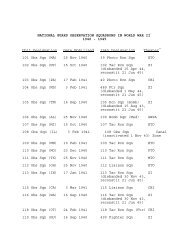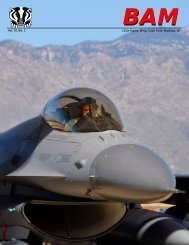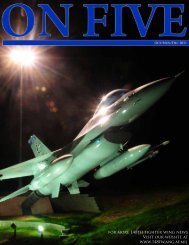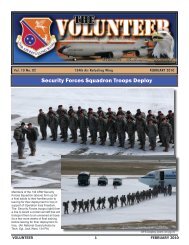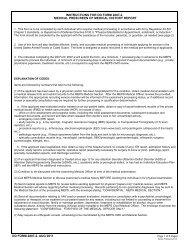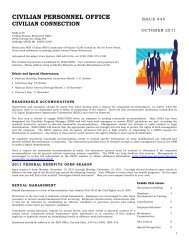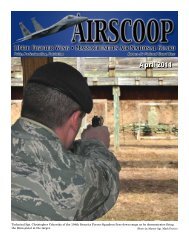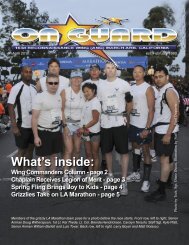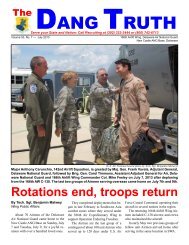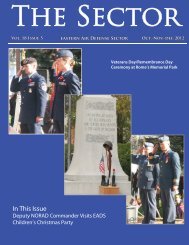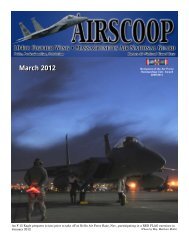a chronological history of the air national guard and its
a chronological history of the air national guard and its
a chronological history of the air national guard and its
You also want an ePaper? Increase the reach of your titles
YUMPU automatically turns print PDFs into web optimized ePapers that Google loves.
DATE: 28 MARCH 2013<br />
A CHRONOLOGICAL HISTORY OF THE AIR NATIONAL<br />
GUARD AND ITS ANTECEDENTS OR THE MONTH OF<br />
APRIL 1908 - 2013<br />
Compiled By:<br />
Charles J. Gross, PhD, GS-14<br />
Director, ANG History<br />
NGB/HO<br />
30 April 1908. Aviation enthusiasts in <strong>the</strong> 1st Company, Signal Corps, New<br />
York National Guard, organized an "aeronautical corps" to learn ballooning. 1<br />
April 1917. The War Department decided that National Guard <strong>air</strong><br />
organizations would be disb<strong>and</strong>ed during <strong>the</strong> World War I mobilization.<br />
Individual Guardsmen would be encouraged to volunteer for aviation duty as<br />
reservists. 2<br />
23 May 1917. The First Aero Company, New York National Guard, was<br />
disb<strong>and</strong>ed. 3<br />
Ca April 1922. JN6H <strong>air</strong>craft from <strong>the</strong> Minnesota National Guard’s 109 th<br />
Observation Squadron (formerly <strong>the</strong> 109 th Squadron) were called to state<br />
active duty to obtain samples near Pike, Minnesota <strong>of</strong> an <strong>air</strong>borne fungus<br />
disease damaging wheat. 4<br />
18 April 1927. 10 <strong>of</strong>ficers <strong>and</strong> 50 enlisted members <strong>of</strong> <strong>the</strong> 154 th Observation<br />
Squadron, Arkansas National Guard <strong>and</strong> <strong>the</strong>ir Curtiss JN-4 <strong>and</strong> JN-6 <strong>air</strong>craft<br />
began performing relief duties during <strong>the</strong> great Mississippi River flood, one <strong>of</strong><br />
<strong>the</strong> worst natural disasters in American <strong>history</strong>. Those Guardsmen <strong>air</strong>lifted<br />
food, medicines, <strong>and</strong> supplies to workers shoring up levees along <strong>the</strong> river.<br />
They also patrolled <strong>the</strong> levees to spot potential breaks <strong>and</strong> worked to plug gaps<br />
in those embankments. Members <strong>of</strong> <strong>the</strong> unit flew over 20,000 miles delivering<br />
serum, food <strong>and</strong> supplies across <strong>the</strong>ir state during <strong>the</strong> flood. The unit was<br />
released from active duty on 3 May 1927. 5<br />
3 April 1937. The last <strong>of</strong> 46 Douglas 0-46 monoplanes were delivered to<br />
Guard un<strong>its</strong>. The 0-46 was <strong>the</strong> first monoplane to become st<strong>and</strong>ard equipment<br />
in Guard aviation squadrons. It featured a fully enclosed cockpit while<br />
retaining fixed l<strong>and</strong>ing gear. 6
10 April 1941. The 121 st Observation Squadron, District <strong>of</strong> Columbia<br />
National Guard, received federal recognition. 7<br />
18 April 1941. The 123 rd Observation Squadron, Oregon National Guard,<br />
received federal recognition. 8<br />
April 1943. Flying during <strong>the</strong> Algeria-Tunisia campaign, <strong>the</strong> 154 th<br />
Observation Squadron, formerly <strong>of</strong> <strong>the</strong> Arkansas National Guard, became <strong>the</strong><br />
first Army Air Forces unit to take P-51 Mustangs, powered by Allison engines,<br />
into combat. 9<br />
12 April 1944. The 840 th Bombardment Squadron (Heavy), formerly <strong>the</strong> 128 th<br />
Observation Squadron, Georgia National Guard, commenced combat operations<br />
with <strong>its</strong> Boeing B-17s from a base in Italy. 10<br />
15 April 1946. Lt. Gen. George E. Stratemeyer, <strong>the</strong> comm<strong>and</strong>er <strong>of</strong> <strong>the</strong> Air<br />
Defense Comm<strong>and</strong>, wrote <strong>the</strong> Chief <strong>of</strong> <strong>the</strong> National Guard Bureau that “The<br />
mission <strong>of</strong> <strong>the</strong> <strong>air</strong> <strong>national</strong> security <strong>of</strong> <strong>the</strong> United States . . . has been assigned<br />
in large measure to <strong>the</strong> Air National Guard.” 11<br />
25 April 1946. General <strong>of</strong> <strong>the</strong> Armies Dwight D. Eisenhower, <strong>the</strong> Army Chief<br />
<strong>of</strong> Staff, approved a revised plan for a new postwar aviation organization that<br />
would be known as <strong>the</strong> Air National Guard. 12<br />
April 1949. Nebraska ANG personnel were called to state duty for<br />
Operation Snowbound. They dropped food <strong>and</strong> hay from a C-47 to farm<br />
families <strong>and</strong> livestock which had been isolated by a severe blizzard in <strong>the</strong><br />
western part <strong>of</strong> <strong>the</strong> state. 13<br />
April 1949. Following a blizzard in <strong>the</strong> nor<strong>the</strong>rn part <strong>of</strong> <strong>the</strong> state, F-51s<br />
from <strong>the</strong> Montana Air Guard’s 186 th Fighter Squadron flew missions to<br />
locate stalled vehicles <strong>and</strong> remote cabins. The fighters were followed by C-47<br />
transports which dropped food <strong>and</strong> clothing near <strong>the</strong> vehicles <strong>and</strong> cabin. Hay<br />
was also dropped to starving livestock by <strong>the</strong> C-47s. 14<br />
April 1950. Air National Guard teams participated in <strong>the</strong> annual U.S. Air<br />
Force Gunnery Meet for <strong>the</strong> first time. The Air Guard was authorized two<br />
teams in <strong>the</strong> competition which was held at Las Vegas, Nevada. Utah’s 191 st<br />
Fighter Squadron, flying F-51s, finished fourth in <strong>the</strong> conventional <strong>air</strong>craft<br />
class. Florida’s 159 th Fighter Squadron, operating F-80s, finished eighth in <strong>the</strong><br />
jet <strong>air</strong>craft class. 15<br />
1 April 1951. ANG flying squadrons mobilized on this date because <strong>of</strong> <strong>the</strong><br />
Korean conflict were <strong>the</strong>: 103rd Bomb Squadron (BS), (Light), Pennsylvania;
106th Tactical Reconnaissance (TRS) (Night Photo), Alabama; 108th BS<br />
(Light), Illinois; 115th BS (Light), California; 117th BS (Light), Pennsylvania;<br />
120th Fighter Squadron (FS), Colorado; 122nd BS (Light), Louisiana; 124th<br />
FS, Iowa; 155th TRS, Tennessee; 168th BS (Light), Illinois; 173rd FS,<br />
Nebraska; 174th FS, Iowa; 178th FS, North Dakota; 180th BS (Light),<br />
Missouri; 185th TRS, Oklahoma; 186th FS, Montana; 187th Fighter Bomber<br />
Squadron (FBS), Wyoming; 190th FS, Idaho; <strong>and</strong> <strong>the</strong> 191st FBS, Utah. 16<br />
1 April 1951. Soon after <strong>its</strong> mobilization on this date during <strong>the</strong> Korean<br />
conflict, <strong>the</strong> Nebraska ANG’s 173rd Fighter Squadron transitioned from F-<br />
80Cs back to F-51s at Bangor, Maine because none <strong>of</strong> <strong>the</strong> four ANG un<strong>its</strong><br />
flying Shooting Stars had enough <strong>of</strong> <strong>the</strong> <strong>air</strong>craft to maintain a full fleet <strong>of</strong><br />
<strong>the</strong>m. Nebraska's F-80s were distributed to <strong>the</strong> o<strong>the</strong>r three un<strong>its</strong>. The<br />
173rd's new mission with F-51s at Bangor was to serve as long range fighter<br />
escorts for SAC bombers. 17<br />
1 April 1951. Mobilized on this date because <strong>of</strong> <strong>the</strong> Korean War, <strong>the</strong><br />
Tennessee Air Guard’s 155 th Tactical Reconnaissance Squadron converted<br />
from F-51Ds to RF-51Ds at <strong>its</strong> home station in Memphis. It was<br />
subsequently reassigned to Shaw AFB, SC, arriving <strong>the</strong>re on 15 January<br />
1952. 18<br />
13 April 1951. The Louisiana Air Guard’s 122nd Bomb Squadron (Light)<br />
moved from New Orleans to Langley AFB, Virginia to become part <strong>of</strong> <strong>the</strong><br />
4400th Combat Crew Training Group. It remained <strong>the</strong>re until it was<br />
returned to state control on 1 January 1953. 19<br />
19 April 1951. Members <strong>of</strong> <strong>the</strong> Air Guard’s 136th Fighter-Bomber Wing<br />
(FBW) were alerted for shipment to <strong>the</strong> Far East because <strong>of</strong> <strong>the</strong> Korean War.<br />
The unit consisted <strong>of</strong> <strong>the</strong> 111th Fighter Bomber Squadron (FBS), Texas,<br />
154th FBS, Arkansas, <strong>and</strong> <strong>the</strong> 182nd FBS, Texas. Previously, <strong>the</strong> wing had<br />
been notified that it would be sent to Western Europe to reinforce <strong>the</strong> North<br />
Atlantic Treaty Organization. 20<br />
20 April 1951. The New Mexico ANG’s 188 th Fighter Squadron moved from<br />
Kirtl<strong>and</strong> AFB, New Mexico to Long Beach Municipal Airport, California<br />
where it served with <strong>the</strong> Air Defense Comm<strong>and</strong> as <strong>the</strong> 188 th Fighter<br />
Interceptor Squadron until returned to state control. It was equipped with P-<br />
51Ds. 21<br />
26 April 1951. The Washington state Air Guard’s 116 th Fighter Interceptor<br />
Squadron was designated to move to Engl<strong>and</strong> on a 90-day temporary duty<br />
assignment, substituting for an Air Force fighter squadron that had been<br />
scheduled to deploy <strong>the</strong>re. 22
April 1951. A Fifth Air Force study revealed that approximately 80 percent<br />
<strong>of</strong> <strong>the</strong> Air Force personnel serving in Korea were recalled Guardsmen <strong>and</strong><br />
reservists. 23<br />
April 1951. The Washington state Air Guard’s 116th Fighter Bomber<br />
Squadron began converting from F-84C to F-86A <strong>air</strong>craft. From April<br />
through June 1951, <strong>its</strong> F-86As were only 38 percent combat ready on average<br />
<strong>and</strong> in-commission only 56.6 percent <strong>of</strong> <strong>the</strong> time. The 116th "attributed <strong>the</strong><br />
situation to <strong>the</strong> fact that <strong>the</strong> <strong>air</strong>craft were in poor condition when <strong>the</strong>y were<br />
transferred to <strong>the</strong> unit." 24<br />
April 1951. Un<strong>its</strong> <strong>of</strong> <strong>the</strong> Air Guard’s mobilized 116th Fighter Bomber Wing<br />
– Georgia’s 158th Fighter Bomber Squadron (FBS), Florida’s 159th FBS, <strong>and</strong><br />
California’s 196th FBS -- began receiving br<strong>and</strong> new Republic F-84Es direct<br />
from <strong>the</strong> factory. 25<br />
April 1952. Selected <strong>air</strong> crews from <strong>the</strong> Air Guard's 126th Bomb Wing<br />
(Light) <strong>and</strong> o<strong>the</strong>r Air Force un<strong>its</strong> in Europe un<strong>its</strong> began deploying to Korea<br />
for 60-day combat tours to improve <strong>the</strong>ir operational training. 26<br />
April 1952. Approximately 400 members <strong>of</strong> <strong>the</strong> Colorado ANG’s 120th<br />
Fighter Squadron participated as human guinea pigs in an atomic bomb test,<br />
"Tumbler Snapper Shot III," at Yucca Flats, Nevada while on temporary duty<br />
from Clovis AFB, New Mexico. 27<br />
April 1952. After being mobilized at <strong>its</strong> home station at Truax Field,<br />
Madison because <strong>of</strong> <strong>the</strong> Korean War, <strong>the</strong> Wisconsin Air Guard’s 176 th Fighter<br />
Interceptor Squadron was partially equipped with F-89As but retained <strong>its</strong> F-<br />
51Ds. It remained at Truax Field until it was returned to state control. 28<br />
3 April 1955. The 129 th Air Resupply Squadron (ARS) was extended federal<br />
recognition in California <strong>and</strong> equipped with Curtiss C-46D Comm<strong>and</strong>o <strong>air</strong>craft.<br />
It was one <strong>of</strong> four new ANG un<strong>its</strong> tasked with secret special operations<br />
missions formed that year at <strong>the</strong> request <strong>of</strong> <strong>the</strong> Air Force <strong>and</strong> <strong>the</strong> Central<br />
Intelligence Agency. The o<strong>the</strong>rs were <strong>the</strong>: 130 th ARS, West Virginia; 135 th ARS,<br />
Maryl<strong>and</strong>; <strong>and</strong> <strong>the</strong> 143 rd ARS, Rhode Isl<strong>and</strong>. The creation <strong>of</strong> those un<strong>its</strong><br />
marked <strong>the</strong> debut <strong>of</strong> <strong>the</strong> special operations mission in <strong>the</strong> Air Guard. 29<br />
April 1959. NASA selected former Minnesota Air Guardsman, Deke<br />
Slayton as one <strong>of</strong> <strong>the</strong> Mercury astronauts. He was <strong>the</strong> first former (or<br />
current) Air Guardsman to be named a NASA astronaut. 30<br />
18 April 1960. The Air Force <strong>of</strong>ficially redesignated <strong>the</strong> former Denver
Naval Air Station as Buckley Air National Guard Base. It was leased to <strong>the</strong><br />
state <strong>of</strong> Colorado <strong>and</strong> operationally assigned to <strong>the</strong> ANG. 31<br />
24 April 1960. The Alaska Air Guard’s 144 th Air Transport Squadron received<br />
<strong>its</strong> first ski-equipped F<strong>air</strong>child C-123J Provider. 32<br />
7 April 1961. A New Mexico ANG F-100 accidentally discharged a heatseeking<br />
Sidewinder missile while making a practice intercept run on a B-52<br />
Strat<strong>of</strong>ortress. The missile shot down <strong>the</strong> Strategic Air Comm<strong>and</strong> bomber<br />
killing three <strong>of</strong> <strong>its</strong> crew members. An Air Force board <strong>of</strong> inquiry absolved <strong>the</strong><br />
Air Guard pilot <strong>of</strong> any blame for <strong>the</strong> tragic accident. 33<br />
19 April 1961. During <strong>the</strong> abortive CIA-sponsored Bay <strong>of</strong> Pigs invasion by<br />
Cuban exiles, four Alabama Air Guardsmen, working as civilian contractors,<br />
were killed in action when <strong>the</strong>ir two B-26s were shot down. The Guardsmen,<br />
who had trained Cuban pilots <strong>and</strong> crews at a secret base in Nicaragua, had<br />
stepped in at <strong>the</strong> last minute to help exhausted Cuban exile <strong>air</strong>crews try to<br />
stave <strong>of</strong>f defeat at <strong>the</strong> Bay <strong>of</strong> Pigs. 34<br />
April 1962. Volunteer pilots <strong>and</strong> ground support personnel from <strong>the</strong><br />
Michigan Air Guard’s 172 nd Tactical Reconnaissance Squadron began<br />
training at Kirtl<strong>and</strong> AFB, New Mexico for Operation Blue Straw, nuclear<br />
tests conducted at Christmas Isl<strong>and</strong> in <strong>the</strong> middle <strong>of</strong> <strong>the</strong> Pacific Ocean. The<br />
172 nd was one <strong>of</strong> five ANG unit that participated in Blue Straw that year.<br />
Flying specially equipped RB-57s, <strong>the</strong>ir pilots flew through clouds <strong>of</strong> nuclear<br />
dust ga<strong>the</strong>r samples for study. 35<br />
April 1962. At <strong>the</strong> request <strong>of</strong> Headquarters, U.S. Air Force, RB-57 <strong>air</strong>craft<br />
from <strong>the</strong> Nevada Air Guard’s 192 nd Tactical Reconnaissance Squadron provided<br />
high altitude photo coverage <strong>of</strong> areas damaged by fire in Arizona <strong>and</strong><br />
California. 36<br />
April 1964. New Jersey’s 141 st Tactical Fighter Squadron became <strong>the</strong> first<br />
ANG unit to convert to <strong>the</strong> Republic F-105 Thunderchief. 37 Maj. Gen. Donald<br />
Strait (NJANG), through his contacts in <strong>the</strong> Department <strong>of</strong> <strong>the</strong> Air Force, had<br />
learned that a number <strong>of</strong> F-105Bs at Seymour-Johnson AFB were grounded<br />
with over 300 TCTOs . He arranged to have <strong>the</strong> <strong>air</strong>craft transferred to <strong>the</strong> 108 th<br />
TFG <strong>of</strong> <strong>the</strong> New Jersey ANG <strong>and</strong> convinced his friends at <strong>the</strong> Republic Aviation<br />
Corporation to provide <strong>the</strong> necessary technical support to fix <strong>the</strong> <strong>air</strong>craft free <strong>of</strong><br />
charge. Republic deployed a team to help fix <strong>the</strong> <strong>air</strong>craft. 38<br />
April 1964. As part <strong>of</strong> an operation named “Carpet <strong>of</strong> Friendship,” ANG<br />
transport <strong>air</strong>craft from Minnesota, New Hampshire <strong>and</strong> Pennsylvania flew
some 120,000 pounds <strong>of</strong> clothing to earthquake-torn San Jorge, a tiny isl<strong>and</strong><br />
in <strong>the</strong> Azores <strong>of</strong>f <strong>the</strong> coast <strong>of</strong> Portugal. 39<br />
April 1965. During <strong>the</strong> U.S. military intervention in <strong>the</strong> Dominican Republic<br />
which began that month, ANG volunteer <strong>air</strong>crews <strong>and</strong> <strong>air</strong>craft flew 43 <strong>air</strong>lift<br />
missions carrying 619 tons <strong>of</strong> cargo in <strong>the</strong> U.S. freeing some Air Force <strong>air</strong>lifters<br />
for direct support <strong>of</strong> <strong>the</strong> contingency operation. 40<br />
1 April 1967. For <strong>the</strong> first time, ANG C-124s made trans-Pacific flights to<br />
Vietnam. The Globemasters included one assigned to <strong>the</strong> 145 th Military Airlift<br />
Group, North Carolina <strong>and</strong> ano<strong>the</strong>r from <strong>the</strong> 116 th Military Airlift Group,<br />
Georgia. 41<br />
28 April 1967. Volunteer crews <strong>and</strong> KC-97Ls from <strong>the</strong> 136th Air Refueling<br />
Wing, Texas, began Operation Creek Party at Rhine Main AB, Germany. The<br />
operation, which lasted 10 years, was <strong>the</strong> ANG's first sustained overseas<br />
volunteer rotation. During Creek Party, <strong>the</strong> Air Guard pioneered <strong>the</strong> use <strong>of</strong><br />
packages <strong>of</strong> volunteers <strong>and</strong> equipment overseas on short (15-30 days) tours <strong>of</strong><br />
active duty overseas to support <strong>the</strong> active duty force. The operation provided a<br />
template for <strong>the</strong> much wider use <strong>of</strong> Air Reserve Components volunteers to<br />
assist <strong>the</strong> active force on short overseas rotations in subsequent decades. 42<br />
April 1967. The National Guardsman magazine reported that <strong>the</strong> Kansas Air<br />
Guard’s 190 th Tactical Reconnaissance Group, one <strong>of</strong> only two remaining ANG<br />
RB-57 un<strong>its</strong>, was providing transition <strong>and</strong> specialized training for Air Force<br />
<strong>air</strong>crews that would fly <strong>the</strong> plane in Vietnam. 43<br />
7 -14 April 1968. The Maryl<strong>and</strong> Air Guard’s 175 th Tactical Fighter Group <strong>and</strong><br />
<strong>its</strong> 135 th Air Resupply Group were called by <strong>the</strong> state’s governor to assist in<br />
dealing with disorders in Baltimore following <strong>the</strong> murder <strong>of</strong> civil rights leader<br />
<strong>the</strong> Reverend Dr. Martin Lu<strong>the</strong>r King, Jr., in Memphis, Tennessee. The Air<br />
Guardsmen were primarily used to protect important installations in Baltimore<br />
<strong>and</strong> <strong>guard</strong> individuals who had been arrested during <strong>the</strong> disturbances. 44<br />
9 April 1968. In <strong>its</strong> first large scale state activation, <strong>the</strong> Delaware ANG was<br />
called to state active duty to quell civil disturbances <strong>and</strong> violence in <strong>the</strong> city<br />
<strong>of</strong> Wilmington, Delaware. Although <strong>the</strong> unit was released from service after<br />
several weeks, many Air Guardsmen remained on state duty through 20<br />
January 1969. 45<br />
April 1968. To support civil authorities working to suppress urban riots<br />
across <strong>the</strong> U.S. after <strong>the</strong> murder in Memphis, Tennessee <strong>of</strong> civil rights leader<br />
<strong>the</strong> Reverend Dr. Martin Lu<strong>the</strong>r King, Jr., ANG <strong>air</strong>lift un<strong>its</strong> employed 162
planes to carry 9,340 passengers <strong>and</strong> almost 1,900,000 pounds <strong>of</strong> cargo while<br />
accumulating 1,756 flying hours. 46<br />
April 1968. Brig. Gen. Willard W. Millikan, <strong>the</strong> comm<strong>and</strong>er <strong>of</strong> <strong>the</strong> 113 th<br />
Tactical Fighter Wing, District <strong>of</strong> Columbia ANG, was assigned as <strong>the</strong><br />
comm<strong>and</strong>er <strong>of</strong> <strong>the</strong> 833rd Air Division, Seymour Johnson AFB, North Carolina.<br />
Millikan <strong>and</strong> his ANG unit had been mobilized during <strong>the</strong> Pueblo crisis. 47<br />
24 April 1969. The 165 th Tactical Reconnaissance Squadron, Kentucky ANG,<br />
<strong>and</strong> <strong>its</strong> <strong>air</strong>craft returned to <strong>the</strong> US from Itazuke Air Base, Japan ending <strong>the</strong><br />
rotation <strong>of</strong> ANG tactical reconnaissance flying squadrons mobilized in 1968 to<br />
that installation. 48<br />
11-17 April 1970. Two <strong>of</strong> <strong>the</strong> three astronauts on <strong>the</strong> aborted Apollo 13 moon<br />
l<strong>and</strong>ing mission were former Air Guard jet fighter pilots. Capt. Fred W. Haise,<br />
Jr. had served in Oklahoma’s 185 th Tactical Fighter Squadron (1957-1959) <strong>and</strong><br />
Ohio’s 164 th Tactical Fighter Squadron (1959-1963). Capt. Russell L. Swigert<br />
had been a member <strong>of</strong> Massachusetts’ 131 st Fighter Interceptor Squadron<br />
(1957-1960) <strong>and</strong> Connecticut’s 118 th Fighter Interceptor Squadron (1960-1965).<br />
Both fliers had been accepted into <strong>the</strong> astronaut program in 1966. 49<br />
16 April 1970. The post held by Maj. Gen. I.G. Brown, <strong>the</strong> Assistant Chief,<br />
National Guard Bureau, Air, was redesignated <strong>the</strong> Director, Air National<br />
Guard, effective this date by a change to AR 130-5/AFR 45-2. The change in<br />
<strong>the</strong> regulation also authorized <strong>the</strong> creation <strong>of</strong> <strong>the</strong> position <strong>of</strong> Deputy Director,<br />
Air National Guard, who would hold a one-star rank. Brig. Gen. John J. Pesch,<br />
a Maine Air Guardsman, was <strong>the</strong> first <strong>of</strong>ficer to serve in that new assignment. 50<br />
25 April 1970. Maryl<strong>and</strong>'s 104th Tactical Fighter Squadron became <strong>the</strong> first<br />
ANG unit to receive Cessna A-37Bs Dragonflies. On this date, it took delivery<br />
<strong>of</strong> <strong>its</strong> first br<strong>and</strong> new, factory fresh Dragonflies. 51<br />
April 1970. California's 115th Tactical Airlift Squadron, converting from C-<br />
97A/Gs to C-130As, became <strong>the</strong> first Air Guard unit to be equipped with <strong>the</strong><br />
Hercules. 52<br />
4 April 1971. Under Operation Creek Guardlift, ANG <strong>air</strong>lift un<strong>its</strong> from<br />
Arizona, New Jersey, Pennsylvania, West Virginia, <strong>and</strong> Wyoming provided<br />
scheduled passenger service from <strong>the</strong> U.S. to Europe. During <strong>its</strong> 12 months <strong>of</strong><br />
existence, <strong>the</strong> operation generated 1,210 sorties carrying 25,649 passengers <strong>and</strong><br />
697,204 pounds <strong>of</strong> cargo. 53<br />
8 April 1971. A C-121 <strong>air</strong>craft <strong>and</strong> crew from <strong>the</strong> 167 th Aeromedical Airlift
Group, West Virginia ANG, flew <strong>its</strong> first Operation Creek Guardlift routine<br />
passenger <strong>and</strong> cargo mission in Europe for USAFE. An <strong>air</strong>crew <strong>of</strong> seven <strong>and</strong><br />
nine ground support personnel from <strong>the</strong> unit participated in <strong>the</strong> first Creek<br />
Guardlift deployment. 54<br />
April 1971. The ANG established an Officers Preparatory Academy (later<br />
renamed <strong>the</strong> Academy <strong>of</strong> Military Science) at <strong>its</strong> Air National Guard<br />
Pr<strong>of</strong>essional Military Education Center at McGhee Tyson Airport, Knoxville,<br />
Tennessee. The Academy served as a commissioning source for Air Guard<br />
<strong>of</strong>ficers. 55<br />
12 April 1971. The first class at <strong>the</strong> ANG Officers Preparatory Academy<br />
began on this date at McGhee-Tyson Airport, Tennessee with 29 students. 56<br />
3 April 1972. Conv<strong>air</strong>’s F-106A/Bs first entered ANG service starting with<br />
Montana’s 186 th Fighter Interceptor Squadron. It was <strong>the</strong> last fighter <strong>air</strong>craft<br />
specifically developed by <strong>the</strong> Air Force for <strong>the</strong> <strong>air</strong> defense mission. 57<br />
21 April 1972. Sergeant Stanford A. Green enlisted in <strong>the</strong> Montana Air<br />
Guard’s 120 th Fighter Group becoming <strong>the</strong> first person to use <strong>the</strong> Air Force’s<br />
new Palace Chase program to transfer from active duty to a reserve component<br />
to fulfill <strong>the</strong> remainder <strong>of</strong> <strong>the</strong>ir military obligation. 58<br />
3 April 1974. To help civil authorities assess damage, RF-101Cs from <strong>the</strong><br />
123 rd Tactical Reconnaissance Wing, Kentucky ANG, photographed areas <strong>of</strong><br />
<strong>the</strong> state devastated by a series <strong>of</strong> deadly tornadoes. 59<br />
3-5 April 1974. After a tornado devastated <strong>the</strong> city <strong>of</strong> Xenia, approximately<br />
800 Air Guardsmen from Ohio’s 178 th Tactical Fighter Group, based in nearby<br />
Springfield, were called up to help deal with <strong>the</strong> catastrophe. They protected<br />
property from looters, conducted search <strong>and</strong> rescue operations, <strong>and</strong> assisted<br />
with initial community cleanup efforts. 60<br />
20 April 1974. Maj. Gen. John L. Pesch, a Maine Air Guardsmen, assumed<br />
<strong>the</strong> post <strong>of</strong> Director, Air National Guard. He replaced Maj. Gen. I.G. Brown <strong>of</strong><br />
Arkansas, <strong>the</strong> longest serving head <strong>of</strong> <strong>the</strong> ANG in <strong>the</strong> NGB. General Brown<br />
had exercised that responsibility since 6 August 1962. 61<br />
18 April 1975. The ANG acquired <strong>its</strong> first jet-powered tanker, a KC-135A, at<br />
<strong>the</strong> 145 th Air Refueling Squadron <strong>of</strong> <strong>the</strong> Ohio Air National Guard. That<br />
development was triggered by a 1974 decision by <strong>the</strong> SECDEF to save money<br />
by transferring 128 <strong>of</strong> those <strong>air</strong>craft to <strong>the</strong> Air Reserve Components (ARC). It<br />
was done despite years <strong>of</strong> opposition by HQ USAF <strong>and</strong> <strong>the</strong> Strategic Air
Comm<strong>and</strong> on <strong>the</strong> grounds that <strong>the</strong> ARC could not meet <strong>the</strong> response times<br />
<strong>and</strong> o<strong>the</strong>r operational requirements levied by <strong>the</strong> active force for those <strong>air</strong>craft<br />
<strong>and</strong> <strong>the</strong>ir crews including <strong>the</strong> critical SIOP nuclear alert mission. 62<br />
April 1975. The 187 th Tactical <strong>air</strong>lift squadron, Wyoming ANG, reported<br />
that <strong>the</strong> first three <strong>of</strong> <strong>its</strong> crews had been trained <strong>and</strong> checked out in <strong>the</strong><br />
Modular Airborne Firefighting System (MAFFS) used for <strong>the</strong> unit’s new<br />
<strong>air</strong>borne firefighting mission. 63<br />
6 April 1976. Flying ski-equipped C-130s, <strong>the</strong> New York Air Guard's 109th<br />
Tactical Airlift Group assumed <strong>the</strong> mission <strong>of</strong> supplying radar sites in<br />
Greenl<strong>and</strong> from <strong>the</strong> Air Force. 64<br />
28 April 1977. Operation Creek Party, <strong>the</strong> ANG volunteer KC-97L tanker<br />
rotation in Germany, was terminated after ten years. During <strong>the</strong> operation, Air<br />
Guardsmen flew 6,512 sorties, completed 47,207 aerial refueling hookups, <strong>and</strong><br />
<strong>of</strong>f-loaded 137,398,620 pounds <strong>of</strong> fuel. The operation demonstrated that <strong>the</strong> Air<br />
Guard could sustain a significant mission overseas for a long period without<br />
resorting to a politically-sensitive mobilization <strong>and</strong> established a template for<br />
<strong>the</strong> widespread use <strong>of</strong> volunteer rotations by <strong>the</strong> Air Reserve Components in<br />
<strong>the</strong> future. 65<br />
1 April 1978. Maj. Gen. John T. Guice, Director <strong>of</strong> <strong>the</strong> Air National Guard,<br />
reported that 97 percent <strong>of</strong> <strong>its</strong> un<strong>its</strong> were combat ready as <strong>of</strong> this date. That<br />
was <strong>the</strong> ANG’s highest ever reported level <strong>of</strong> combat readiness up to that point<br />
in <strong>its</strong> <strong>history</strong>. 66<br />
30 April 1979. On this date, <strong>the</strong> 103 rd Fighter Wing, Connecticut ANG,<br />
became <strong>the</strong> first Air Guard unit to receive <strong>the</strong> A-10 (Tail No. 78-756). 67<br />
1 April 1980. Effective this date, Rickenbacker Air Force Base was transferred<br />
from <strong>the</strong> Strategic Air Comm<strong>and</strong> to <strong>the</strong> Air National Guard by <strong>the</strong> Department<br />
<strong>of</strong> <strong>the</strong> Air Force. Concurrently, it was redesignated Rickenbacker Air National<br />
Guard Base. 68<br />
1 April 1981. Maj. Gen. John B. Conaway, a Kentucky Air Guardsman,<br />
became <strong>the</strong> Director <strong>of</strong> <strong>the</strong> Air National Guard. 69<br />
April 1981. Personnel <strong>and</strong> six A-10As from <strong>the</strong> Maryl<strong>and</strong> Air Guard’s 175 th<br />
Tactical Fighter Group deployed to Hahn Air Base, Germany to participate in<br />
Checkered Flag for <strong>the</strong> first time. The latter was a program developed by <strong>the</strong><br />
Tactical Air Comm<strong>and</strong> to minimize <strong>the</strong> time it would take individual fighter
un<strong>its</strong> to deploy to preplanned specific collocated operating bases in Europe to<br />
prepare for a possible war against <strong>the</strong> Soviet Union <strong>and</strong> <strong>its</strong> Warsaw Pact allies.<br />
Under Checkered Flag, <strong>the</strong> 175 th deployed to <strong>its</strong> Hahn three times during <strong>the</strong><br />
1980s. 70<br />
1 April 1983. The Headquarters, Virgin Isl<strong>and</strong>s Air National Guard, was<br />
activated on this date. 71<br />
6 April 1984. Astronaut Terry J. Hart, a Texas Air Guard F-4C pilot, served<br />
as a mission specialist on <strong>the</strong> Space Shuttle Challenger (STS-41C) which was<br />
launched on this date. The Challenger l<strong>and</strong>ed safely on 13 April 1984. 72<br />
1 April 1986. Under Operation Creek Klaxon, <strong>the</strong> ANG established an <strong>air</strong><br />
defense alert detachment at Ramstein Air Base, Germany while <strong>the</strong> Air Force’s<br />
86 th Tactical Fighter Wing converted from F-4Es to F-16s. A rotational force <strong>of</strong><br />
8 F-4D <strong>air</strong>craft <strong>and</strong> 96 personnel from ANG F-4 interceptor <strong>and</strong> general<br />
purpose fighter un<strong>its</strong> performed <strong>the</strong> <strong>air</strong> defense alert commitment. Altoge<strong>the</strong>r,<br />
<strong>the</strong> all-Air Guard operation included personnel <strong>and</strong> equipment from 22 F-4, 7<br />
<strong>air</strong> refueling, <strong>and</strong> 3 <strong>air</strong>lift un<strong>its</strong>. The volunteer ANG rotation ended on 1 April<br />
1987. 73<br />
April 1986. National Guard magazine reported that Colonel A. Marlene<br />
Ausen had become <strong>the</strong> first Air National Guard <strong>of</strong>ficer to be promoted to <strong>the</strong><br />
rank <strong>of</strong> full colonel. She was <strong>the</strong> Air Guard nurse advisor to <strong>the</strong> chief <strong>of</strong> <strong>the</strong><br />
Air Force Nurse Corps. Colonel Ausen was a Nurse Practitioner assigned to<br />
<strong>the</strong> Virginia ANG. Earlier in her career, she had been a faculty member at<br />
<strong>the</strong> University <strong>of</strong> Wisconsin (1973-1976) <strong>and</strong> <strong>the</strong> University <strong>of</strong> Virginia (1976-<br />
1981) where she taught nursing. 74<br />
April 1986. During a scheduled rotation to Great Britain, a KC-135 <strong>and</strong> crew<br />
from Washington state's 141st Air Refueling Group supported Operation<br />
Eldorado Canyon, <strong>the</strong> bombing <strong>of</strong> suspected terrorist facilities in Libya. 75<br />
April 1986. F-4Ds <strong>and</strong> 240 personnel from <strong>the</strong> District <strong>of</strong> Columbia Air<br />
Guard’s 113 th Tactical Fighter Wing deployed to Keflavik Naval Air Station,<br />
Icel<strong>and</strong> for two-weeks <strong>of</strong> training with <strong>the</strong>ir active duty Air Force counterparts<br />
who were stationed at that base. 76<br />
5 April 1987. Detachment 1 <strong>of</strong> <strong>the</strong> Florida Air Guard’s 125 th Fighter<br />
Interceptor Group, located at Homestead AFB, Florida, scrambled <strong>its</strong> new F-16<br />
Fighting Falcons for <strong>the</strong> first time in <strong>the</strong> <strong>air</strong> defense alert mission that <strong>the</strong> unit<br />
had assumed on April 1 st . 77
10 April 1987. John F. Lehman, Jr., Secretary <strong>of</strong> <strong>the</strong> Navy, resigned effective<br />
this date. Lehman had begun his military career as a member <strong>of</strong> <strong>the</strong><br />
Pennsylvania Air Guard’s 111 th Tactical Air Support Group clinic’s from 1965 to<br />
1968, serving as a medical administrator trainee. He had assumed <strong>the</strong> Navy’s<br />
top post on 5 February 1981. 78<br />
25 April 1987. While st<strong>and</strong>ing alert at Keflavik Air Base, Icel<strong>and</strong>, a crew <strong>and</strong><br />
HC-130P from <strong>the</strong> California Air Guard’s 129 th Aerospace Rescue <strong>and</strong> Recovery<br />
Squadron (ARRS) assisted an Air Force HH-3E <strong>and</strong> crew rescue a Soviet sailor<br />
with a broken pelvis <strong>and</strong> fractured hip 200 nautical miles <strong>of</strong>f Icel<strong>and</strong>’s coast. 79<br />
April 1989. The United States Supreme Court refused to overturn a lower<br />
court ruling that upheld <strong>the</strong> constitutionality <strong>of</strong> <strong>the</strong> “Montgomery Amendment”<br />
to <strong>the</strong> National Defense Authorization Act <strong>of</strong> 1987. That amendment<br />
prohibited state governors from refusing to allow <strong>the</strong>ir Guardsmen to train<br />
overseas. Several governors had gone to federal court to prevent <strong>the</strong>ir<br />
Guardsmen from training in Central America because <strong>the</strong>y opposed<br />
controversial U.S. foreign policies in that region. Under <strong>the</strong> amendment,<br />
governors who blocked overseas training by <strong>the</strong>ir Guardsmen risked losing<br />
federal funding <strong>and</strong> equipment for <strong>the</strong>ir Army <strong>and</strong> Air Guard organizations. 80<br />
4 April 1990. The 210 th Air Rescue Squadron, Alaska ANG, was extended<br />
federal recognition but did not accept <strong>its</strong> first Sikorsky MH-60G until 6 July<br />
1990 <strong>and</strong> <strong>its</strong> first HC-130H(N) until 15 October 1990. 81<br />
1 April 1991. The 210th Rescue Squadron, Alaska Air Guard, began<br />
performing rescue alert duties at Kulis Air National Guard Base. It was <strong>the</strong><br />
newest <strong>of</strong> <strong>the</strong> Air Guard’s three rescue squadrons. 82<br />
5 April 1991. Operation Provide Comfort (I), <strong>the</strong> relief <strong>and</strong> protection <strong>of</strong> Kurds<br />
in nor<strong>the</strong>rn Iraq, against <strong>the</strong> Iraqi government was launched by <strong>the</strong> U.S. led<br />
combined task force. 83<br />
28 April 1991. Astronaut <strong>and</strong> Texas Air Guard fighter pilot Charles Lacy<br />
Veach served as a mission specialist on <strong>the</strong> Space Shuttle Discovery (STS-39)<br />
launched on this date. It was his first space flight. The Discovery returned<br />
safely to earth on 6 May 1991. 84<br />
8 April 1992. Col. Roberta V. Mills, a nurse originally from <strong>the</strong> Tennessee Air<br />
Guard, became <strong>the</strong> first woman ever promoted to general <strong>of</strong>ficer rank in <strong>the</strong><br />
ANG. 85<br />
30 April 1992. C-130 <strong>air</strong>crews from <strong>the</strong> 146 th Airlift Wing at Channel
Isl<strong>and</strong>s Air Base, California were alerted at 1:15 AM <strong>and</strong> began flying cargo,<br />
soldiers, equipment, police <strong>of</strong>ficers, <strong>and</strong> vehicles to various locations in <strong>the</strong><br />
state to deal with riots caused by <strong>the</strong> beating <strong>of</strong> motorist Rodney King by Los<br />
Angeles police <strong>of</strong>ficers. The first C-130 departed <strong>its</strong> home station at 5:25 AM<br />
that day as part <strong>of</strong> an operation named “Sudden Response.” On that day, <strong>the</strong><br />
unit flew 57 flight hours, hauled 663 passengers, <strong>and</strong> carried more than 40<br />
tons <strong>of</strong> cargo. On 1 May, 125 security police from 4 ANG flying un<strong>its</strong> were<br />
activated <strong>and</strong> deployed to locations in sou<strong>the</strong>rn California. Arizona <strong>and</strong><br />
Wyoming ANG un<strong>its</strong> also provided <strong>air</strong>lift for <strong>the</strong> operation. 86<br />
7 April 1994. Maj. Gen. Donald W. Shepperd, <strong>the</strong> Director <strong>of</strong> <strong>the</strong> Air National<br />
Guard, approved a concept developed by <strong>the</strong> 101 st Air Refueling Wing, Maine<br />
ANG, <strong>and</strong> <strong>the</strong> 157 th Air Refueling Group, New Hampshire, to establish a new<br />
Nor<strong>the</strong>ast Tanker Task Force at <strong>the</strong>ir home stations after <strong>the</strong> Air Force’s<br />
Plattsburg Tanker Task Force was eliminated due to <strong>the</strong> programmed closure<br />
<strong>of</strong> Plattsburg AFB, New York in 1995. 87<br />
April 1994. The first Kansas Air Guardsmen <strong>of</strong> <strong>the</strong> 184th Fighter Group<br />
returned from initial B-1B training at Dyess AFB, Texas <strong>and</strong> began flying <strong>the</strong><br />
<strong>air</strong>craft with active-duty bomber crews <strong>of</strong> <strong>the</strong> 384th Bomb Wing at McConnell<br />
AFB, Kansas. 88<br />
20 April 1995. Members <strong>of</strong> <strong>the</strong> 138th Fighter Group, Oklahoma ANG, began<br />
providing emergency assistance after <strong>the</strong> 19 April 1995 bombing <strong>of</strong> <strong>the</strong> Alfred<br />
P. Murrah Federal Building in Oklahoma City. 89<br />
April 1995. Maj. Gen. Donald W. Shepperd, <strong>the</strong> Air National Guard’s<br />
Director, asked <strong>the</strong> 192nd Fighter Wing, Virginia ANG, to develop pods to use<br />
with <strong>its</strong> F-16s to restore a manned tactical photo reconnaissance capability to<br />
<strong>the</strong> total Air Force. Gen. Ronald Fogleman, Air Force Chief <strong>of</strong> Staff, had<br />
requested that <strong>the</strong> Air Guard to take on this project after <strong>the</strong> service had<br />
decided to retire <strong>its</strong> last dedicated tactical photo reconnaissance <strong>air</strong>craft, <strong>the</strong><br />
RF-4C. That initiative was known as <strong>the</strong> Theater Airborne Reconnaissance<br />
System program. 90<br />
1 April 1996. The 116th Fighter Wing, Georgia ANG, was redesignated <strong>the</strong><br />
116th Bomb Wing <strong>and</strong> received <strong>its</strong> first B-1B bomber. It was <strong>the</strong> second ANG<br />
unit to be equipped with that <strong>air</strong>craft. 91<br />
20 April 1996. The last F-4 Phantom II's in <strong>the</strong> total Air Force’s inventory,<br />
four F-4G "Advanced Wild Weasels" from <strong>the</strong> ANG's 124th Fighter Wing at<br />
Gowen Field, Idaho, were retired <strong>and</strong> flown to Davis-Monthan AFB, Arizona. 92<br />
April 1996. The ANG deployed 12 C-130s, 24 crews, <strong>and</strong> 378 volunteers to
Ramstein AB, Germany for Operation Joint Endeavor. All ANG C-130 un<strong>its</strong><br />
participated in this deployment, supporting peace-keeping in Bosnia, which<br />
ended in June 1996. 93<br />
April 1997. SSgt Gregg Tyler, a member <strong>of</strong> New York’s 105 th Airlift Wing<br />
<strong>and</strong> a New York state trooper, became <strong>the</strong> first Air Guardsmen to complete<br />
“Phoenix Raven” training. “Phoenix Raven” was <strong>the</strong> <strong>of</strong>ficial designation for<br />
members <strong>of</strong> an Air Force unit trained to provide security for U.S. military<br />
<strong>air</strong>craft when <strong>the</strong>y flew to 45 <strong>of</strong> <strong>the</strong> world’s most remote nations. 94<br />
1 April 1998. Lt. Col. Bob Berkl<strong>and</strong> <strong>of</strong> Louisiana comm<strong>and</strong>ed a team <strong>of</strong> 61<br />
Air Guard medical pr<strong>of</strong>essionals from 32 states, augmented by 7 Air Force<br />
<strong>and</strong> Air Force Reserve medical personnel that took charge <strong>of</strong> <strong>the</strong> active force’s<br />
25-bed <strong>air</strong> transportable hospital at remote Prince Sultan Air Base in Saudi<br />
Arabia <strong>and</strong> ran it until August. While deployed, <strong>the</strong>y supported Operation<br />
Sou<strong>the</strong>rn Watch, <strong>the</strong> UN-sanctioned no-fly zone over sou<strong>the</strong>rn Iraq, <strong>and</strong><br />
responded to <strong>the</strong> bombing <strong>of</strong> <strong>the</strong> US embassy in N<strong>air</strong>obi, Kenya by terrorists.<br />
The deployment was <strong>the</strong> first known instance <strong>of</strong> Air Guardsmen running an<br />
Air Force hospital. 95<br />
1 April 1999. An EC-130 Comm<strong>and</strong>o Solo <strong>air</strong>craft from <strong>the</strong> 193rd Special<br />
Operations Wing, Pennsylvania ANG, flew south from Ramstein AB, Germany<br />
<strong>and</strong> began broadcasting radio <strong>and</strong> television programs to nor<strong>the</strong>rn Serbia as<br />
part <strong>of</strong> Operation Allied Force. 96<br />
7 April 1999. Maj. Gen. Paul A. Weaver, Jr., <strong>the</strong> ANG Director, announced<br />
<strong>the</strong> formation <strong>of</strong> a "Future Forces Team" in <strong>the</strong> NGB to help reshape <strong>the</strong> Air<br />
Guard for <strong>the</strong> 21st century. 97<br />
12 April 1999. Maj. Gen. Paul A. Weaver, Jr., <strong>the</strong> ANG Director, activated <strong>the</strong><br />
ANG Crisis Action Team at Andrews AFB, Maryl<strong>and</strong> to h<strong>and</strong>le Air Guard<br />
tanker issues related to Operation Allied Force, <strong>the</strong> <strong>air</strong> war for Bosnia. 98<br />
13 April 1999. Gen. Wesley Clark, USA, Supreme Allied Comm<strong>and</strong>er Europe,<br />
asked for 300 more U.S. <strong>air</strong>craft for use in Operation Allied Force in addition to<br />
<strong>the</strong> 82 <strong>air</strong>craft that he had requested on April 9th. His request would bring <strong>the</strong><br />
total U.S. <strong>air</strong>craft committed to <strong>the</strong> operation to 800. Pentagon spokesman<br />
Kevin Bacon said this might require a presidential selective reserve call-up. 99<br />
14-15 April 1999. Approximately 100 members <strong>of</strong> New York's 107th Air<br />
Refueling Wing (ARW) deployed to Turkey with 4 KC-135Rs for a month-long<br />
tour <strong>of</strong> duty with Operation Nor<strong>the</strong>rn Watch. They teamed up <strong>the</strong>re with<br />
personnel from New Hampshire's 157th ARW. 100
21 April 1999. The Office <strong>of</strong> <strong>the</strong> Assistant Secretary <strong>of</strong> Defense/Reserve<br />
Aff<strong>air</strong>s reported that over 500 volunteers from <strong>the</strong> Air Force Reserve <strong>and</strong> <strong>the</strong><br />
Air Guard were supporting Operation Allied Force overseas <strong>and</strong> in <strong>the</strong><br />
continental US. 101<br />
26 April 1999. Pentagon <strong>of</strong>ficials announced that Secretary <strong>of</strong> Defense<br />
William Cohen had ordered 30 tankers, <strong>the</strong>ir <strong>air</strong>crews <strong>and</strong> support personnel,<br />
to deploy by 1 May 1999 for active duty with Operation Allied Force. A mix <strong>of</strong><br />
active duty Air Force <strong>and</strong> Air Reserve Components assets, <strong>the</strong>y would be sent<br />
overseas in response to <strong>the</strong> Supreme Allied Comm<strong>and</strong>er Europe’s request<br />
earlier in April for additional U.S. military <strong>air</strong>craft. 102<br />
27 April 1999. Secretary <strong>of</strong> Defense William S. Cohen announced that<br />
President Bill Clinton had approved a Presidential Selective Reserve Call-Up to<br />
support <strong>the</strong> NATO <strong>air</strong> war for Kosovo, Operation Allied Force. It authorized<br />
<strong>the</strong> mobilization <strong>of</strong> up to 33,102 members <strong>of</strong> <strong>the</strong> Selected Reserve. The initial<br />
increment <strong>of</strong> approximately 2,000 would be members <strong>of</strong> ANG <strong>and</strong> Air Force<br />
Reserve <strong>air</strong>-refueling un<strong>its</strong>. 103<br />
28 April 1999. Headquarters, United States Air Force issued a Presidential<br />
Selective Reserve Call-Up message for Operation, maintaining <strong>the</strong> no-fly zone<br />
over sou<strong>the</strong>rn Iraq. Air Combat Comm<strong>and</strong> was authorized to mobilize<br />
elements <strong>of</strong> <strong>the</strong> ANG's 106 th <strong>and</strong> 129 th Rescue Wings <strong>and</strong> deploy <strong>the</strong>m to <strong>the</strong><br />
Persian Gulf region. 104<br />
17 April 2000. To help maintain order during a meeting <strong>of</strong> <strong>the</strong> world’s<br />
finance ministers in <strong>the</strong> nation’s capital, District <strong>of</strong> Columbia National<br />
Guardsmen were called into active duty to assist local <strong>and</strong> federal law<br />
enforcement <strong>of</strong>ficers deal with protestors who attempted to disrupt <strong>the</strong> event.<br />
Some 300 Guardsmen, including 24 Security Forces personnel from <strong>the</strong> 113 th<br />
Wing, DC Air Guard were sworn in as special police <strong>of</strong>ficers during <strong>the</strong> callup.<br />
Overall, <strong>the</strong> protest demonstrations remained peaceful. 105<br />
8 April 2001. In a change <strong>of</strong> comm<strong>and</strong> ceremony, Brig. Gen. Mary Ann Eps<br />
took over as <strong>the</strong> Assistant Adjutant General for Air, Connecticut. She was <strong>the</strong><br />
first African American female to hold that assignment in <strong>the</strong> ANG. General<br />
Eps was a nurse in civilian life. 106<br />
1 April 2002. The total number <strong>of</strong> Air Guardsmen serving (voluntary <strong>and</strong><br />
mobilized) on federal taskings following <strong>the</strong> 11 September 2001 terrorist<br />
attacks on <strong>the</strong> United States peaked at 24,566. 107<br />
14 April 2002. The Los Angeles Times reported that <strong>the</strong> California Air<br />
Guard’s 146 th Airlift Wing at Channel Isl<strong>and</strong>s ANG Station was scheduled to
acquire eight br<strong>and</strong> new C-130J Hercules <strong>air</strong>craft. 108<br />
15 April 2002. The total number <strong>of</strong> Air Guardsmen serving in mobilized<br />
status following <strong>the</strong> 11 September 2001 terrorist attacks on <strong>the</strong> United States<br />
peaked at 21,011. 109<br />
18 April 2002. An F-16 pilot assigned to <strong>the</strong> 183 rd Fighter Wing, Illinois ANG,<br />
who thought he was under attack from unidentified ground forces mistakenly<br />
dropped a bomb killing four Canadian soldiers <strong>and</strong> wounding eight more in<br />
sou<strong>the</strong>rn Afghanistan. The Canadians were conducting a live-fire training<br />
exercise at night. 110<br />
15 April 2003. The total number <strong>of</strong> Air Guardsmen serving in mobilized<br />
status following <strong>the</strong> 11 September 2001 terrorist attacks on <strong>the</strong> United States<br />
peaked at 21,011. 111<br />
11 April 2005. An <strong>air</strong>crew from <strong>the</strong> 175 th Wing, Maryl<strong>and</strong> ANG made <strong>the</strong><br />
first short-field, dirt <strong>air</strong>strip l<strong>and</strong>ing with a C-130J in <strong>the</strong> U.S. Central<br />
Comm<strong>and</strong>’s area <strong>of</strong> operational responsibility when <strong>the</strong>ir wheels touched<br />
down at Forward Operating Base Salerno in Afghanistan. The crew had to<br />
load an oversized cargo, a 25,000 pound fire truck <strong>and</strong> deliver it to an<br />
undisclosed location. They took <strong>of</strong>f from a 4,000-foot strip from a high<br />
elevation weighing 137,000 pounds. 112<br />
April 2005. Leaders <strong>of</strong> <strong>the</strong> Virginia ANG’s 192 nd Fighter Wing (FW) <strong>and</strong> <strong>the</strong><br />
Air Force’s 1 st FW signed a memor<strong>and</strong>um <strong>of</strong> underst<strong>and</strong>ing that laid out <strong>the</strong><br />
scope <strong>of</strong> <strong>the</strong> Air Guard’s new associate wing that will help <strong>the</strong> Air Force<br />
operate <strong>and</strong> maintain F/A-22 Raptors at Langley AFB, Virginia. It<br />
represented a key milestone in <strong>the</strong> service’s Future Total Force initiatives<br />
that sought to better integrate <strong>the</strong> active, Guard, <strong>and</strong> Reserve components <strong>of</strong><br />
<strong>the</strong> Air Force. 113<br />
26 April 2006. Senator Christopher Bond (R- Missouri), co-ch<strong>air</strong> <strong>of</strong> <strong>the</strong><br />
Senate’s National Guard caucus, introduced bipartisan legislation (S.2658) to<br />
streng<strong>the</strong>n <strong>the</strong> National Guard Bureau’s role in <strong>the</strong> Pentagon’s decisionmaking<br />
processes. In <strong>the</strong> House, Representative Tom Davis (R-Virginia)<br />
introduced legislation that same day (H.R. 5200) designed to achieve that<br />
same basic objective. 114<br />
24 April 2007. The Ohio Air Guard’s 178 th Fighter Wing hosted a ceremony<br />
<strong>of</strong>ficially welcoming <strong>the</strong> Royal Ne<strong>the</strong>rl<strong>and</strong>s Air Force to <strong>its</strong> Springfield-<br />
Beckley home station <strong>and</strong> celebrating <strong>the</strong> new joint US-Dutch F-16 pilot<br />
training program at that installation. 115
8 April 2008. In accordance with <strong>the</strong> 2005 BRAC law, <strong>the</strong> last A-10<br />
Thunderbolt II <strong>air</strong>craft assigned to <strong>the</strong> 118th Fighter Squadron, 103d Fighter<br />
Wing, Connecticut ANG, departed Bradley ANGB. 116<br />
4 April 2009. The West Virginia ANG’s 167 th Airlift Wing was formally<br />
dedicated as a fully operational C-5 unit in a ceremony at Martinsburg, West<br />
Virginia. 117<br />
24 April 2009. Two ASA F-16s from <strong>the</strong> 121 st Fighter Squadron, 113th Wing,<br />
DC ANG based at Andrews AFB, Maryl<strong>and</strong>, were scrambled to intercept a<br />
small single-engine <strong>air</strong>plane that strayed into restricted <strong>air</strong>space near <strong>the</strong><br />
U.S. Capitol. In addition, two US Coast Guard helicopters assisted in <strong>the</strong><br />
intercept <strong>and</strong> escorted <strong>the</strong> plane to Indian Head Airport in Charles County,<br />
Maryl<strong>and</strong>. The White House said President Obama had briefly relocated <strong>and</strong><br />
<strong>the</strong> occupants <strong>of</strong> <strong>the</strong> Capitol had evacuated during <strong>the</strong> incident. 118<br />
27 April 2009. The Mississippi ANG’s 186 th Air Refueling Wing took<br />
possession <strong>of</strong> <strong>the</strong> MC-12W, <strong>the</strong> Air Force’s newest ISR platform. A temporary<br />
MC-12 mission qualification training detachment will be established at <strong>the</strong><br />
unit’s home station, Key Field, in part because <strong>of</strong> <strong>its</strong> long experience (12<br />
years) flying ano<strong>the</strong>r manned ISR <strong>air</strong>craft, <strong>the</strong> RC-26. 119<br />
27 April 2010. The first <strong>of</strong> 20 Block 50 F-16s l<strong>and</strong>ed at <strong>the</strong> home station <strong>of</strong><br />
<strong>the</strong> 148 th Fighter Wing <strong>of</strong> <strong>the</strong> Minnesota ANG at Duluth to replace <strong>the</strong> unit’s<br />
current Block 25 Vipers. 120<br />
27 April 2010. The South Dakota Air Guard’s 114 th Fighter Wing received<br />
<strong>the</strong> first <strong>of</strong> <strong>its</strong> 22 new Block 40 F-16s that will replace <strong>its</strong> Block 30 models. 121<br />
28 April 2010. Senior Air Force <strong>of</strong>ficials told members <strong>of</strong> <strong>the</strong> House <strong>of</strong><br />
Representatives during congressional hearings that <strong>the</strong> service would<br />
temporarily delay a plan to retire <strong>the</strong> C-130s Puerto Rico Air Guard’s 156 th<br />
Airlift Wing next year until a follow-on mission could be found for <strong>the</strong> unit.<br />
The cuts had been included in <strong>the</strong> USAF’s proposed FY 2011 budget. 122<br />
7 April 2011. On this date, 10,484 Air Guardsmen (2,320 mobilized <strong>and</strong><br />
8,164 volunteers) were on federal active duty. 123<br />
23 April 2011. Members <strong>of</strong> <strong>the</strong> 212 th Rescue Squadron, Alaska ANG<br />
participated alongside members <strong>of</strong> <strong>the</strong> 33d Rescue Squadron in a daring<br />
mountainside rescue attempt <strong>of</strong> crashed coalition helicopter in <strong>the</strong> Kapisa<br />
province, Afghanistan. 124
SOURCE NOTES<br />
1 Rene J. Francillon, The Air Guard (Aerograph 2, undated), p.11; Charles J.<br />
Gross, The Air National Guard <strong>and</strong> <strong>the</strong> American Military<br />
Tradition,(Washington, DC: National Guard Bureau, 1995), p. 26.<br />
2 Charles J. Gross, Prelude To The Total Force: The Air National Guard,<br />
1943-1969, (Washington, DC: Office <strong>of</strong> Air Force History, U. S. Air Force,<br />
1985), p. 2.<br />
3 Gross, American Military Tradition, p 31.<br />
4 The Air National Guard in Minnesota, 1921 To 1971: A Fifty Year History<br />
Of Pioneering, Progress And Service To State And Nation, (Department <strong>of</strong><br />
Military Aff<strong>air</strong>s, State <strong>of</strong> Minnesota, 1970), p 22.<br />
5 Rpt (U), Militia Bureau, “Annual Report <strong>of</strong> <strong>the</strong> Chief Of The Militia Bureau<br />
[FY] 1927,” Washington, D.C.: USGPO, 1927, pp. 3, 77; Arkansas Air<br />
National Guard, From Jennies To Jets; 50th Anniversary, 1925-1975, 154th Observation SQ., (Lear Siegler, Inc., Oklahoma City, Oklahoma, circa 1975),<br />
p. 4.; Francillon, United States Air National Guard, pp. 25, 104; Article (U),<br />
“Ano<strong>the</strong>r Flood That Stunned America,” U.S. News & World Report ,undated,<br />
http://www.usnews.com/usnews/news/articles/050912/12leadall.b.htm.<br />
6 Francillon, Air Guard, p. 24; Francillon, United States Air National Guard,<br />
pp. 28, 187.<br />
7 Francillon, Air Guard, p. 19.<br />
8 Francillon, Air Guard, p. 19.<br />
9 Francillon, Air Guard, pp. 33,122.<br />
10 Francillon, Air Guard, p. 34.<br />
11 Study (S/RD/NOFORN), “The Air National Guard In Air Defense,” p. 2, info<br />
used was (U).<br />
12 Gross, American Military Tradition, p. 62.<br />
13 Col. Fred H. Bailey, Jr., NE ANG, Coordinator-Editor, Ready And Able:<br />
The Story <strong>of</strong> <strong>the</strong> Nebraska Air National Guard, 1946 to 1981, (Nebraska<br />
ANG,1981), p 20.<br />
14 CMSgt Joseph K. Kuzara, Headquarters, Montana ANG, Editor, Montana<br />
Air National Guard: The First 50 Years, (Montana ANG, ca 1997), p 6.<br />
15 Article (U), “Guard Plays Major Role In USAF Gunnery Meet,” The<br />
National Guardsman, May 1950, p. 15.<br />
16 ANG Unit Data Cards, NGB-PAH, Air National Guard Historical<br />
Archives.<br />
17 Douglas R. Hartman, Nebraska's Militia: The History <strong>of</strong> <strong>the</strong> Army <strong>and</strong> Air<br />
National Guard, 1854-1991, (Virginia Beach, VA; The Donning Co., 1994), p.<br />
181.<br />
18 Francillon, United States Air National Guard, p 167.<br />
19 Francillon, United States Air National Guard, p 127.<br />
20History (U), 136th FBW, 1 April - 30 June 1951, pp 1-2; Francillon, United<br />
States Air National Guard, p 44.
21 Francillon, United States Air National Guard, p 145.<br />
22 Ritchie, "History <strong>of</strong> <strong>the</strong> 116th FIS, 1951-1952," pp 8-9.<br />
23 Gross, Prelude, p. 59.<br />
24 Ritchie, "116th FIS, 1951-1952," pp 11-13.<br />
25 David R. McLaren, Republic F-84, Thunderjet, Thunderstreak, &<br />
Thunderflash: A Photo Chronicle, (Atglen, PA: Schiffer Military/Aviation<br />
History, 1998), p 113.<br />
26 Illinois Air National Guard Fiftieth Anniversary, 1927-1977, pp 40-41; Hist<br />
(U), USAFE, July - December 1952, Volume I, pp 26-27.<br />
27 Colorado Pride, p 87.<br />
28 Francillon, United States Air National Guard, p 176.<br />
29 Francillon, The United States Air National Guard, p.106; Charles J. Gross,<br />
Ph.D., Adapting The Force Evolution <strong>of</strong> <strong>the</strong> Air National Guard’s Air Mobility<br />
Missions, (Arlington, VA: NGB-PAI-H, 1999), pp. 10-11.<br />
30 Biography (U), Lyndon B. Johnson Space Center, NASA, “Deke Slayton<br />
(Mr.), NASA Astronaut (Deceased),” June 1993,<br />
http://www.jsc.nasa.gov/Bios/htmlbios/slayton.html.<br />
31 Colorado Pride, pp 106-107, 111.<br />
32 News Item (U), “Ski Planes Deliver Supplies,” The National Guardsman,”<br />
August 1960, p. 26.<br />
33 Maj. Gen. John Pershing Jolly, Adjutant General <strong>of</strong> New Mexico, History,<br />
National Guard <strong>of</strong> New Mexico, 1606-1963,(Santa Fe, New Mexico, 30<br />
September 1963), p 132; Article (U), “Out Of A Clear Blue Sky,” The National<br />
Guardsman, June 1961, p. 3..<br />
34 Trest <strong>and</strong> Dodd, Wings <strong>of</strong> Denial, pp.11, 13, 134<br />
35 110 th FW History Office, Future Minus 50: History <strong>of</strong> <strong>the</strong> Battle Creek Air<br />
National Guard, 1947-1997, (Battle Creek, MI: 110 th FW, June 1997), p 47.<br />
36 Rpt (U), NGB, Subj.: “Annual Report <strong>of</strong> <strong>the</strong> Chief, National Guard Bureau,<br />
Fiscal Year 1962,” p.37.<br />
37 Francillon, United States Air National Guard, pp. 144, 204.<br />
38 Oral History (U), Maj. Gen. Donald Strait, NJANG (Ret), with David P.<br />
Anderson, Edited by Bl<strong>air</strong> Haworth, NGB/HO, publication pending March<br />
2012.<br />
39 The Air National Guard in Minnesota, 1921 To 1971: A Fifty Year History<br />
Of Pioneering, Progress And Service To State And Nation, (Department <strong>of</strong><br />
Military Aff<strong>air</strong>s, State <strong>of</strong> Minnesota, 1970), p 180.<br />
40 Gross, Prelude, , p. 148; Francillon, United States Air National Guard, p.<br />
156; Francillon, Air Guard, p. 59; Berberian, “Return <strong>of</strong> <strong>the</strong> Strategic<br />
Minuteman,” p. 9.<br />
41 News Item (U), “Air Guard C124s Make First Runs To Vietnam,” The<br />
National Guardsman, May 1967, p. 27.<br />
42 Gross, Mobility Milestone, p 5.<br />
43 News Item (U), “Kansas Train USAF Aircrews And Ethiopian Airman,”
The National Guardsman, April 1967, p. 16.<br />
44 Col, Ball, The Maryl<strong>and</strong> Air National Guard, pp. 89, 96.<br />
45 Brig. Gen. (Ret.) Kennard R. Wiggins, Jr., <strong>and</strong> Lt. Col. Stephen A. Caton,<br />
Delaware Air National Guard 60 th Anniversary, 1946-2006, (Delaware ANG,<br />
ca 2006), p 24.<br />
46 Article (U), “Civil Disturbances: The Aftermath …or <strong>the</strong> Intermission,” The<br />
National Guardsman, June 1968, pp. 8, 12.<br />
47 Rick Mitchell, A History <strong>of</strong> <strong>the</strong> District <strong>of</strong> Columbia Air National Guard,<br />
(Andrews AFB, MD: DC ANG, October 4, 1996, Final Edition), p.60.<br />
48 Francillon, United States Air National Guard, p. 66.<br />
49 News Item (U), “Two Air Guardsmen In APOLLO XIII,” The National<br />
Guardsman, May 1970, p 22; Roger D. Launius, NASA: A History <strong>of</strong> The U.S.<br />
Civil Space Program, (Malabar, FL.: Krieger Publishing Co., 1994), p. 91.<br />
50 Gross, American Military Tradition, p. 197; Pamphlet (U), Julius<br />
Rothstein, NGB-PA, “The History <strong>of</strong> <strong>the</strong> National Guard Bureau,” undated, p.<br />
10; Rpt (U), NGB-PA, Subj.: “Annual Report Chief, National Guard Bureau<br />
Fiscal Year 1970,” undated, p. 65.<br />
51 Francillon, Air Guard, p. 86; Maryl<strong>and</strong> ANG, Maryl<strong>and</strong> Air National<br />
Guard, p. 116; Hist (FOUO), CY 1998 – CY 2000, p. 30, info used was (U).<br />
52 Gross, Mobility Milestones, p 14;<br />
53 Kondratiuk, “ANG Airlift,” p. 6; Article (U), “Creek Guardlift” The National<br />
Guardsman, August-September 1971, p. 30 Rpt (U), NGB, “Annual Report,<br />
Fiscal Year 1972, Chief, National Guard Bureau,” undated, pp. 54-55.<br />
54 Hist (U), Capt. John P. Lewis, 167 Aeromedical Airlift Group, West<br />
Virginia ANG, “History <strong>of</strong> <strong>the</strong> 167 th Aeromedical Airlift Group: 1 January<br />
1970-31 December 1971,” 15 March 1972, pp 14-15; Francillion, The United<br />
States Air National Guard, p 175.<br />
55 Rpt (U), NGB, Subj.: “Annual Report <strong>of</strong> <strong>the</strong> Chief, National Guard Bureau,<br />
Fiscal Year 1973,” p. 48.<br />
56 Rpt (U), NGB, Subj.: “Annual Report Fiscal Year 1971 Chief, National<br />
Guard Bureau,” p 49.<br />
57 Francillon, United States Air National Guard, p.182; Photo Caption (U),<br />
Subj.: First F-106 In ANG Service, The National Guardsman, June 1972, p.<br />
37.<br />
58 Cook, Through Airmen’s Eyes, p. 61.<br />
59 LeMay <strong>and</strong> Trowbridge, Fortune Favors <strong>the</strong> Brave, p 35.<br />
60 Article (U), Col. Arnold Lacy, 178 th TFG Comm<strong>and</strong>er, “Xenia Tornado –<br />
The Air Guard Was There,” The Air Reservist, June 1974, pp. 8-9.<br />
61 Gross, American Military Tradition, p. 197.<br />
62 Gross, Adapting The Force, p 39.<br />
63 Pamphlet (U), Wyoming ANG, “Wyoming Air National Guard: The Cowboy<br />
Guard, 40 th Anniversary Reunion, 1946-1986,” undated, p 11.<br />
64 News Item (U), National Guard, August 1993, p. 20.
65 News Item (U), The National Guardsman, May 1977, p. 2; Charles J.<br />
Gross, Mobility Milestones An Air National Guard Chronology, (Washington,<br />
DC: National Guard Bureau, September 1996), p.15.<br />
66 News Item (U), “ANG Combat Ready,” The National Guardsman, July<br />
1978, p. 29.<br />
67 Email (U), SMSgt David P. Anderson, NGB-PAH, to Maj. Richard Ofcarcik,<br />
ANG/LMC, Subj.: “RE: A-10 in <strong>the</strong> NAG questions,” 16 February 2006, 3:33<br />
PM, DOC 2006-2; Email (U), SMSgt David P. Anderson, NGB-PAH, to<br />
Charles Gross, NGB-PAH, Subj.: “FW: ANG A-10s,” 17 February 2006, 7:57<br />
AM, DOC 2006-1.<br />
68 Special Order GA-34 (U), Department <strong>of</strong> <strong>the</strong> Air Force, 20 May 1980, DOC<br />
2012-1.<br />
69 Gross, American Military Tradition, p. 197.<br />
70 Col. Ball, The Maryl<strong>and</strong> Air National Guard, p. 139.<br />
71 Francillon, United States Air National Guard, p. 173.<br />
72 Article (U), “From Fighter Jocks to Astronauts: Guardsmen Take to <strong>the</strong><br />
Heavens,” National Guard, September 1983, pp. 16-18, 35; Biographical<br />
Data (U), Lyndon B. Johnson Space Center, NASA, Subj.: “Terry J. Hart<br />
NASA Astronaut (Former),” January 2006,<br />
http://www.jsc.nsa.gov/Bios/htmlbios/hart-tj.html..<br />
73 Rpt (U), NGB, Subj.: “Annual Review <strong>of</strong> <strong>the</strong> Chief, National Guard Bureau<br />
[FY] 1987,” undated p. 56; Rpt (U), Det. 11, ANGSC, “After Action Report<br />
Project Creek Klaxon, Ramstein AB, Germany, Det. 11, ANGSC, 1 Apr 1986<br />
– 1 April 1987,” undated, passim, in ANG Historical Archives, NGB-PAH.<br />
74 Article (U), “First ANG Female Col,” National Guard,<br />
April 1986, p 72; Air War College Research Report (U),<br />
Colonel Marlene Ausen, et. al., “Noncombatant Evacuation<br />
Operations (NEO) And Repatriation: How Can The Process Be<br />
Improved?,” (Air War College, Maxwell AFB, Al, 1988), p<br />
iv.<br />
75 Gross, Mobility Milestones, p 16.<br />
76 Article (U), Maj. Lu<strong>the</strong>r L. Walker, “Coronet Kiowa: Defending <strong>the</strong> Skies <strong>of</strong><br />
<strong>the</strong> North Atlantic,” National Guard, October 1986, pp. 28-30.<br />
77 Article (U), Capt. Jean Marie Brawders, Assistant Editor, “Florida’s<br />
Fighting Falcons: Chasing Bears From <strong>the</strong> Keys,” National Guard, June<br />
1987, p. 26.<br />
78 Article (U), “Navy Goes Guard,” National Guard, September 1985, p. 39;<br />
Naval Historical Center Home Page (U), “FAQs,” “Frequently Asked<br />
Questions,” “Secretaries <strong>of</strong> <strong>the</strong> Navy, Individuals Serving As,”<br />
www.<strong>history</strong>.navy.mil/..<br />
79 Hist (U), 129 ARRS, CA ANG, 1 Jan – 31 Dec 1987, p 2.<br />
80 Gross, American Military Tradition, pp. 130-131; Article (U), “Supreme<br />
Court Rejects Dukakis Appeal, Upholds Montgomery Amendment on
OCONUS Training,” National Guard, June 1989, p. 10.<br />
81 Francillon, United States Air National Guard, p. 101.<br />
82 Rpt (U), NGB, "Annual Review <strong>of</strong> <strong>the</strong> Chief, National Guard Bureau, Fiscal Year<br />
1992," undated, p. 52.<br />
83 Article (U), Daniel L. Haulman, “Crisis in Iraq: Operation Provide<br />
Comfort,” Short <strong>of</strong> War: Major USAF Contingency Operations, 1947-1997, A.<br />
Timothy Warnock, editor, (Maxwell AFB, AL: Air Force History <strong>and</strong><br />
Museums Program in association with Air University Press, 2000), pp. 179-<br />
188.<br />
84 Article (U), SGT Laurence Rogers, NY ARNG, “Facing Challenges,”<br />
National Guard, October 1993, p. 84; Biographical Data (U), Lyndon B.<br />
Johnson Space Center, NASA, “Charles Lacy Veach,” October 1995,<br />
http://www.jsc.nasa.gov/Bios/htmlbios/veach.html.<br />
85 Hist (U), ANG CY 1992 – CY 1994, p. x.<br />
86 Article (U), Capt Phil Blahut, Editor, “C-130s <strong>air</strong>lift soldiers, cargo to riot<br />
scene,” The National Guard On Guard, June 1992, pp. 1, 3<br />
87 Extract (U), AMC History, 1 June 1992- 31 December 1994, pp. 45-46, <strong>and</strong><br />
Supporting Document, DOC 2006-30.<br />
88 Lynch, "Bombers in <strong>the</strong> Guard," p 34.<br />
89 Chronology (U), Hist (FOUO/PV), 138th FW, 1 Jan 1995 - 31 Dec 1998, p<br />
xi, info used was (U).<br />
90 Article (U), Capt Debbie Magaldi, Virginia ANG, "Virginia Guard Provides<br />
New Eyes To The Air Force," National Guard, December 1996, p 22; Hist (U),<br />
ANG, CY 1995-CY 1997, pp. ix, 114-115.<br />
91 Article (U), Andrew Compart, "Long Journey Finally Ends," Air Force<br />
Times, 22 April 1996, p 21.<br />
100. Article (U), Vago Muradin, "Farewell to <strong>the</strong> Phantoms," Air Force Times, 8<br />
April 1996, p 24; Article (U), Steven Watkins, "Radar-hunters will retire," Air Force<br />
Times, 10 June 1996, p 26.<br />
93 Rpt (U), NGB, Subj.: “Annual Review <strong>of</strong> <strong>the</strong> Chief, National Guard<br />
Bureau, Fiscal Year 1996,” undated, p 63.<br />
94 Article (U), MSgt Bob Haskell, “Original Raven,” The On Guard,<br />
September 2000, p 7.<br />
95 Article (U), MSgt Bob Haskell, “Medical team Saudi bound,” The On Guard, May<br />
1998, pp 1, 13; Rpt (U), NGB, Subj.: “Annual Review Of The Chief National Guard<br />
Bureau Fiscal Year 1998,” undated, p 83.<br />
96 Article (U), Tom Bowman, "National Guard Plane 'Shoots' Message At<br />
Yugoslav Audience," Baltimore Sun, 5 June 1999, SD CHRON-24, Hist<br />
(FOUO), ANG, CY 1998 - CY 2000.<br />
97 Msg. (U), NGB-CF to AIG 7300, et al, Subj.: "Shaping The Air National<br />
Guard For The 21st Century," 070729Z April 1999, SD CHRON-25, Hist<br />
(FOUO), ANG, CY 1998 - CY 2000.
98 Hist (FOUO), ANG, CY 1998-CY 2000, p. xiv, info used was (U).<br />
99 Article (U), Jim Garamone, "NATO Requests 300 More U.S. Aircraft for<br />
Allied Force," American Forces Press Service, 14 April 1999, SD CHRON-27,<br />
HIST (FOUO), ANG, CY 1998 - CY 2000.<br />
100 Article (U), Capt. Linda D. Blaszak, 107th ARW, NY ANG, "From Niagara<br />
to Nor<strong>the</strong>rn Watch," Thunderbird, May 1999, p 4, SD CHRON-28, Hist<br />
(FOUO), ANG, CY 1998 - CY 2000.<br />
101 News Release (U), Lt. Col. Milord, ASD/RA, "Reservists eager for duty<br />
with U.S. Kosovo force," by Doug Meegren, Associated Press, "Reserve Forces<br />
- April 21, 1999, Current News," DOC 99-04.<br />
102 Article (U), Jim Garamone, "30 Aerial Refuelers Ordered to Allied Force,"<br />
American Forces Press Service, 27 April 1999, SD CHRON-30, Hist (FOUO),<br />
ANG, CY 1998 - CY 2000.<br />
103 Memo (U), SECDEF William S. Cohen for <strong>the</strong> Secretaries <strong>of</strong> <strong>the</strong> Military<br />
Departments <strong>and</strong> <strong>the</strong> Ch<strong>air</strong>man, JCS, Subj.: "Presidential Callup <strong>of</strong> <strong>the</strong><br />
Selected Reserve <strong>and</strong> Certain Individual Ready Reserve Members in Support<br />
<strong>of</strong> Kosovo Operations," 27 April 1998, SD CHRON-31, Hist (FOUO), ANG, CY<br />
1998 - CY 2000; News Release (U),OASD/PA, No. 197-99, "Secretary Cohen<br />
Announces Presidential Selective Reserve Call-Up," 27 April 1999, p 1, SD<br />
CHRON-32, Hist (FOUO), ANG, CY 1998 - CY 2000; Article (U), Bradley<br />
Graham, "Clinton Tells Pentagon To Call Up Reservists," Washington Post,<br />
28 April 1999, p 1, SD CHRON-33, HIST (FOUO), ANG, CY 1998 - CY 2000.<br />
104 Msg (U), HQ USAF/XOP to HQ ACC, et al, Subj.: "Presidential Selective<br />
Reserve Call-Up (PSRC) For Operation Sou<strong>the</strong>rn Watch," 280756Z April<br />
1999, SD CHRON-34, Hist (FOUO), ANG, CY 1998 - CY 2000.<br />
105 Article (U), MSgt Bob Haskell, NGB, “D.C. troops called to calm protest,”<br />
The On Guard, May 2000, pp 1, 4.<br />
106 Article (U), Lizabeth Hall, “Taking Comm<strong>and</strong> With Pride,” Hartford<br />
Courant, 9 April 2001, p 3, DOC 2001-5.<br />
107 Hist (S/NOFORN), ANG, CY 2001-CY 2004, p. xviii, info used was (U).<br />
108 Article (U), “3 Air Bases To Get More Cargo Planes,” Los Angeles Times,<br />
April 14, 2002.<br />
109 Bfg Chart (U), Col. Bunting, ANG/DP, Subj.: “Personnel Force<br />
Management,” undated, see SUPDOCS, Chapter VI, Hist (S/NOFORN),<br />
ANG, CY 2001-CY 2004, info used was (U).<br />
110 Hist (S/NOFORN), ANG, CY 2001-CY 2004, p. xix, info used was (U).<br />
111 Hist (S/NOFORN), ANG, CY 2001-CY 2004, p. xxiii, info used was (U).<br />
112 Article (U), Maj Bernadette Dozier, Public Aff<strong>air</strong>s, “C-130J crew test skills<br />
in Afghanistan,” The On Guard, June 2005, p 13.<br />
113 Article (U), Staff Report, “Guard, Active Wings Sign MOU Governing New<br />
Partnership,” The On Guard, May 2005, p7.<br />
114 Congressional Record-Senate (U), S.2658, Mr. Bond, 26 April 2006, DOC<br />
# 8 p S3593; Paper (U), Library <strong>of</strong> Congress, Subj.: S. 2658 List <strong>of</strong> Cosponsors
[through 27 June 2007], DOC #9, passim ; Congressional Record article (U),<br />
Library <strong>of</strong> Congress, Subj.: “Introduction <strong>of</strong> <strong>the</strong> National Defense<br />
Enhancement <strong>and</strong> National Guard Empowerment Act <strong>of</strong> 2006 – (Extensions<br />
<strong>of</strong> Remarks – April 26, 2006), Speech <strong>of</strong> Hon. Tom Davis <strong>of</strong> Virginia in <strong>the</strong><br />
House <strong>of</strong> Representatives, Wednesday April 26, 2006,” DOC 10, pp1,7-9.<br />
115 Article (U), SRA Bethany Vital, 178 th FW/PA, “Dutch Touch Down: 178 th<br />
Fighter Wing Scores New Mission Training Dutch Pilots On F-16 Fighter<br />
Jets,” Buckeye Guard, Spring/Summer 2007, pp 18-19, Doc 2007-8.<br />
116 (U)Email (U), Detorie, Francis N, Col, 103 AW/CC, to Anderson, David P,<br />
NGB/PAH, “(U) ANG C-21 History,” 6 July 2010, SD 3066.<br />
117 News Item (U), “ANG C-5 Wing Gains IOC,” Air Force Magazine, June<br />
2009, p 15.<br />
118 (U) Article (U), “(U) Plane strays, Obama Relocated,” Philadelphia<br />
Inquirer, 25 April 2009, SD 6062.<br />
119 Photo Caption (U), “New Bird On <strong>the</strong> Block,” Air Force Magazine, June<br />
2009, p 18,<br />
120 Article (U), 2d Lt Jodi L. Kiminski, 148th Fighter Wing Public Aff<strong>air</strong>s,<br />
“148th Fighter Wing gets new wings,” Air Force Print News Today, 5 May<br />
2010; News Item (U), Michael Sirak, Executive Editor, with Marc Schanz,<br />
“ANG Gets Newer F-16s,” in “Air Force World” section, Air Force Magazine,<br />
July 2010, pp 13-14.<br />
121 News Item (U), Michael Sirak, Executive Editor, with Marc Schanz, “ANG<br />
Gets Newer F-16s,” in “Air Force World” section, Air Force Magazine, July<br />
2010, pp 13-14.<br />
122 News Item (U), Michael Sirak, Executive Editor, with Marc Schanz, “ANG<br />
Gets Newer F-16s,” in “Air Force World” section, Air Force Magazine, July<br />
2010, p 20.<br />
123 Rpt. (U), “April 2011 ANG Kneeboards Data,” p.5, 5/13/2011 3:52 PM, in<br />
documents file for Chapter I, M&O, CY 10-13 [ANG] History.<br />
124 Article (U), Captain Erick Saks, “Alaska Guard unit plays major role in<br />
rescue <strong>of</strong> “fallen angel,” National Guard, 4 May 2011.





